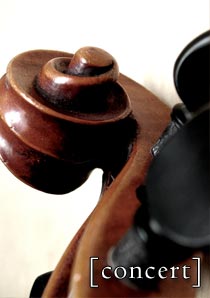Illumination
| Year Composed: | 2014 |
| Instrumentation: Concerto for Piano, Percussion, Strings | pno / perc / strings |
| Duration | 20 minutes |
| I | Gardens of Ice |
| II | Quicksilver |
| III | Einstein's Dreams |
Audio Excerpts (MP3)
Program Notes
Illumination, a Double Concerto for Piano, Percussion, and Strings, is a work conceived in three movements, all of which—unlike my previous multi-movement works—share only the most tenuous of thematic and narrative connections.The sources that have served as inspiration for each movement are similarly varied. Initially, I had thought that the two soloists would serve as opposite characters, with the pianist representing the world of rational enlightenment, and the percussion serving the darker, more primal and perhaps more impassioned role—reflecting a dichotomy inspired by the populist (and, admittedly, reductionist) view of left-brain versus right-brain characteristics. The title, Illumination, emerged from this line of thought, as well as from my ruminations on Albert Einstein’s work on the relativity of time and space and the constancy of light (the famous physicist does figure into this work, albeit in an alternative guise.) In the end, there is no particularly profound motivation for the resulting instrumentation, apart from a certain colouristic kinship between the instruments, as well as (of course) my enjoyment of previous repertory of the same instrumentation.
If there is a unity to be found among these three disparate movements, I suspect it may lie in my experimentations with form (both internally and at the multi-movement resolution), my attempts to circumvent certain formal obstacles, and my (occasional) urge to twist and fracture the surface fabric in order to unveil the depths beneath.
The first and briefest movement, “Gardens of ice,” provides a succinct and bright-eyed introduction to the sound world of this concerto. It was inspired by the Toronto ice storm in December, 2013, where thousands of residents found themselves out of power for days at a time. Tremendous inconvenience aside, I was struck by the immediate and arresting beauty of the images in the aftermath of the storm—trees twisted by ice into haunting sculptures, white snowdrifts falling upon a darkened urban landscape. The piece opens with a series of gentle, shimmering chords (beginning on G major, chromatically shifting to D-flat and A-flat), with the piano providing cascading textures and the bowed vibraphone hovering in the atmosphere. This is followed by agitated, chromatically-descending chords in the piano, with the strings providing immense swells of opposing triads, like gusts of wind. The movement concludes gently but mysteriously.
“Quicksilver” is a traditional scherzo movement, devoid of programmatic content. Here, the low-end of the percussion battery is introduced (bass drum, tom-toms); the marimba features prominently as well. The music moves mercurially between virtuosic confrontations, a light, Debussy-like dance, a trio section featuring a flowing chorale, and finally, a brazen cadenza for solo percussion.
At the heart of the concerto is the final movement, titled “Einstein’s Dreams,” which spans a duration longer than the previous movements combined. Cast as a loose, sprawling chaconne, this movement was inspired by the novel of the same title by Canadian physicist and humanist Alan Lightman. The novel eschews traditional narrative in favour of a series of surrealistic vignettes about the nature of time—fictionalized accounts of Einstein’s dreams as he worked feverishly to complete his revolutionary theory of relativity. These vignettes are woven together to form a mysterious, moving essay on the contradictions of human nature.
Sixteen variations, each corresponding to one of Einstein’s dreams, are built upon a heavy, fatalistic theme in the strings. These are interrupted occasionally by interludes for solo piano and vibraphone, which correspond to Einstein’s waking moments—ironically the ‘dreamiest’ portions of the movement. The variations themselves span a broad range of style and temperament, from the mysterious (time flows like water), the metrically complex (mechanical versus intuitive time), the confused (cause and effect are jumbled), the radiant (life only lasts the span of a day), the propulsive (time slows for those who move quicker), the static (frozen time); and so on. One variation (people trapped in time) contains strange, ghostly references to the first two movements. Fluttering strings, suggestive of nightingales, characterize the final variation; beneath the airy wings of these nightingales (which grant time to anyone who can capture them) tolls the chaconne theme in the low register of the piano, eternal and absolute.
Performances
- June 1, 2014 - Victor Cheng, piano; Michelle Colton, percussion; Sneak Peek Orchestra, conducted by Kevin Lau. St. Gabriel's Passionist Parish, North York.
- May 13, 2019 - Synchronicity, percussion; Pit Stop Players. Cary Hall, DiMenna Center for Classical Music; New York, NY.
Commisions and Awards
- commissioned by Mary Kenedi with generous assistance from the Ontario Arts Council (2013).
Video
ILLUMINATION - Double Concerto for Piano and Percussion - May 13 2019 from Gregory Landes on Vimeo.

